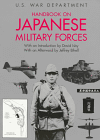|
|
|
|
| Missing In Action (MIA) | Prisoners Of War (POW) | Unexploded Ordnance (UXO) |
| Chronology | Locations | Aircraft | Ships | Submit Info | How You Can Help | Donate |
|
 US War Department Louisiana State Univ Press 1995 Soft cover 300 pages Index, photos ISBN 0807120138 Cover Price: $24.95 Language: English Order this book online via amazon.com Return to |
Handbook on Japanese Military Forces The first editions of this book appeared in 1942 to fill a chronic need for intelligence data on an enemy about whom there was more than an element of mythology associated. The book was compiled by a Washington based group of intelligence experts, helped by British and Australian intelligence data from the battlefield. As David Isby states in his introduction, accuracy was not just desirable, it could be a matter of life and death. It contained data that could be relied on in combat and now nearly 60 years on, the researcher looking for accuracy in writing on the Japanese armed forces of WW2 can also rely on it. The first chapters go into great detail on the organisation of the Japanese army. The detail is quite extraordinary and includes colour plates showing uniforms and insignia. Chapter 4 deals with the air service and besides photos, has an excellent series of silhouette diagrams. One can well imagine how vital such information was to the training of Allied pilots, air gunners and anti air gunners. For me one of the most complete sections deals with
the nature of Japanese defensive positions. Many diagrams and aerial
photos of such positions are used in the book to demonstrate how they
were used. The value of this information in deciphering recon photos
as well as planning assaults was incalculable. The detailed maps of
the layout of the Japanese defences at Buna makes possible a definitive
study of an action by overlaying the Australian assault routes. It is
quite sobering to realize that had the attacking units had this map
in their hands at the time, how many lives The weapons and equipment section can certainly be considered the definitive guide. Recently a veteran showed me a strange small bakelite container with a dispensing hole at one end that he had souveniered from a Japanese soldier during the war. Deciphering the text I found it had something to do with alcohol, and sure enough there was a photo in the handbook, it was a syringe for antifreeze liquid for the eyepieces of gas masks. As I said, the definitive guide. It makes an excellent reference for Eric Bergerud's Touched with Fire where the characteristics of Japanese weaponry is discussed. The original reason I purchased the book was to get access to the final part of the book, where all Japanese military symbols are identified and the English and Japanese names given. For anyone working with Japanese military maps and histories, this section is a must. In fact, a Japanese military researcher originally put me onto the book. Review by Phil Bradley Return to Book Reviews | Add a review or submit for review Last Updated |
| Discussion Forum | Daily Updates | Reviews | Museums | Interviews & Oral Histories |
|